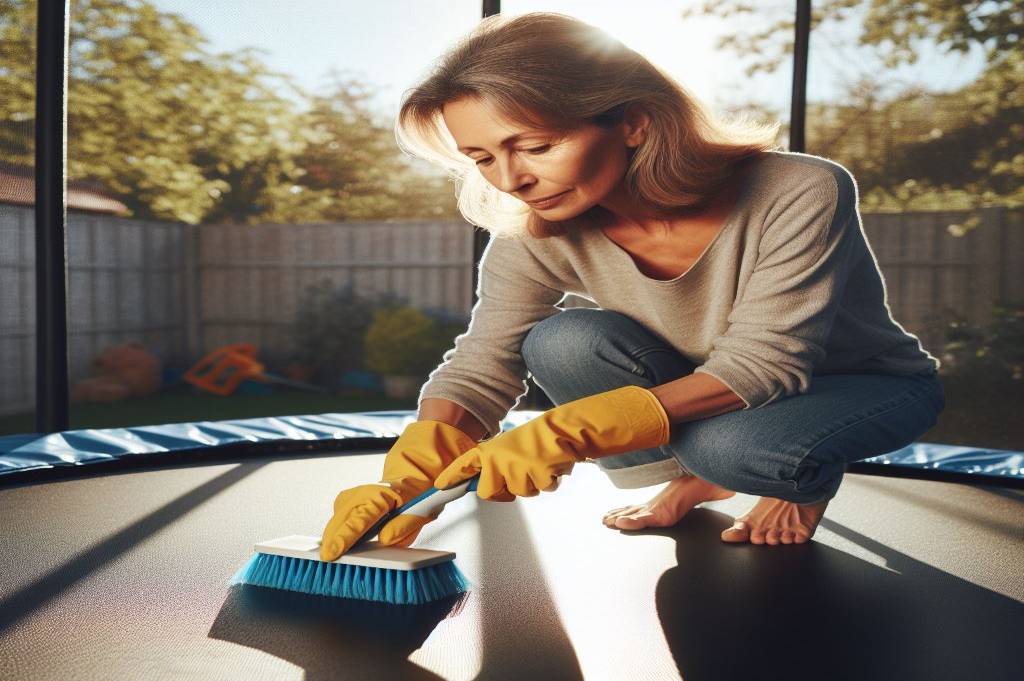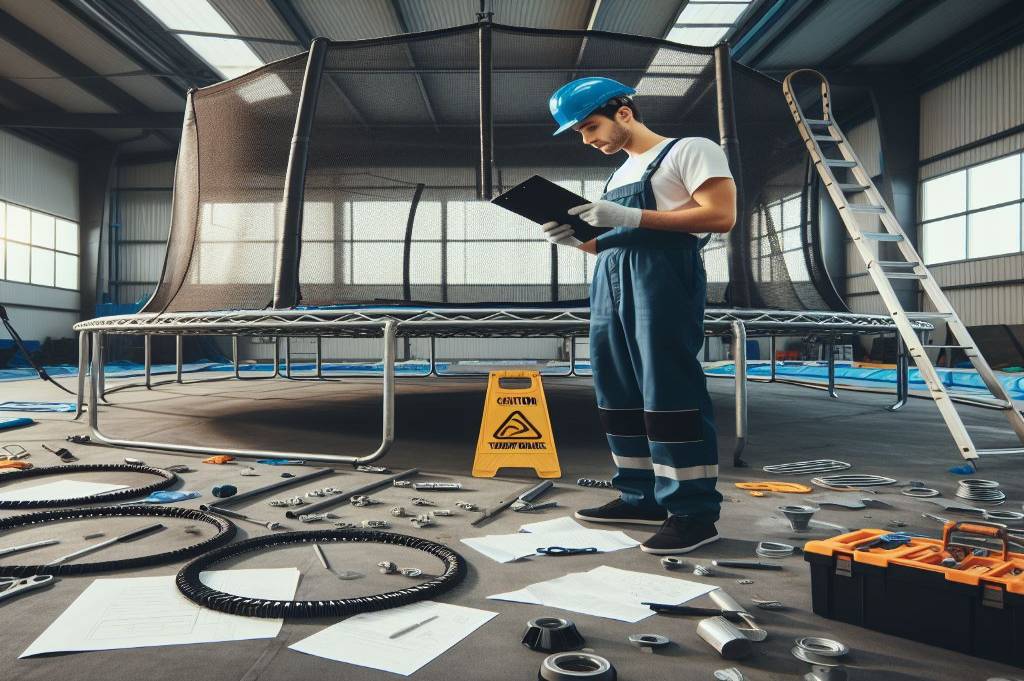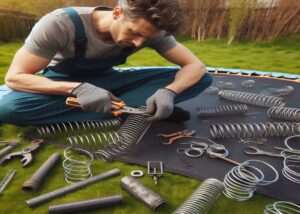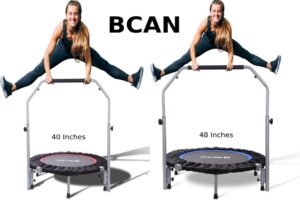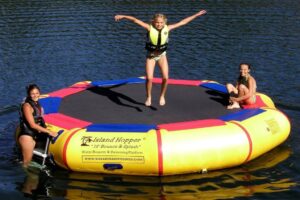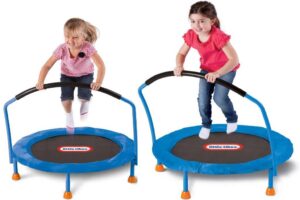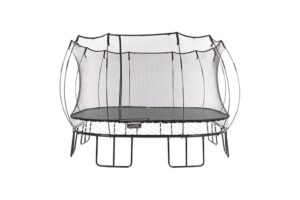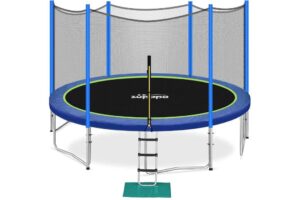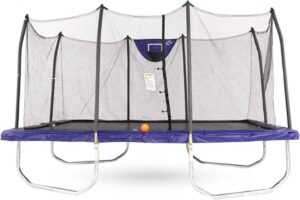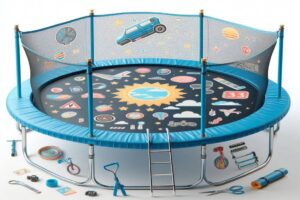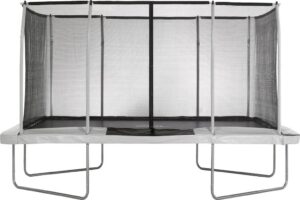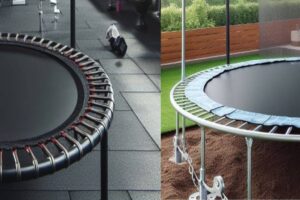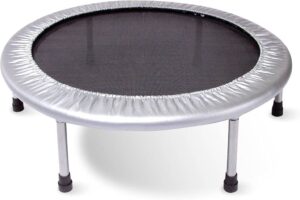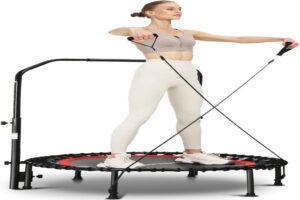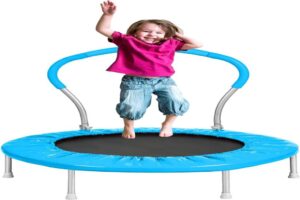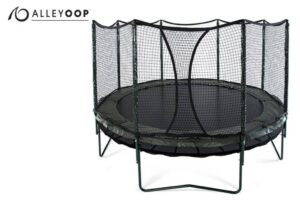Introduction
Trampoline cleaning is essential for maintaining a safe and enjoyable bouncing experience. Trampolines are not just backyard playthings; they’re gateways to boundless fun and exercise. But with great bouncing comes great responsibility – the responsibility to maintain your trampoline. In this guide, we’ll delve into the crucial aspects of trampoline maintenance, focusing specifically on cleaning. Let’s start by understanding why keeping your trampoline clean is of paramount importance and the myriad benefits it brings.
Understanding the Importance of Trampoline Cleaning
Trampoline cleaning is an integral part of overall maintenance. Regular trampoline cleaning ensures that the surface remains free from dirt, debris, and moisture, reducing the risk of damage and ensuring long-term durability.
Additionally, trampoline cleaning enhances safety by providing better traction and minimizing the risk of slips and falls. By regularly cleaning the surface, springs, and frame, you can prevent rust and corrosion, keeping your trampoline sturdy and secure.
Benefits of Trampoline Cleaning
- Enhanced Safety: Trampoline cleaning improves traction, reducing the likelihood of accidents and injuries.
- Prolonged Lifespan: Regular trampoline cleaning removes debris that can cause wear and tear, extending the life of your equipment.
- Improved Performance: A clean trampoline bounces better, offering a more effective and enjoyable workout.
- Health and Hygiene: Trampoline cleaning eliminates dirt and mold, promoting a healthier environment for users.
- Aesthetics: Clean trampolines enhance the appearance of your backyard, creating a more inviting space for family and friends.
In conclusion, trampoline cleaning is essential for maintaining safety, durability, and performance. By understanding the importance of trampoline cleaning and embracing its benefits, you can ensure that your trampoline remains a source of joy for years to come. Stay tuned for practical tips and techniques for effective trampoline cleaning.
Preparation
Before diving into the task of trampoline cleaning, it’s crucial to gather the necessary supplies and take appropriate safety precautions. In this guide, we’ll cover everything you need to ensure a smooth and safe cleaning process.
Gathering Necessary Supplies
- Trampoline Cleaner: Choose a mild detergent or specialized trampoline cleaner to effectively remove dirt and grime without damaging the surface.
- Soft Bristle Brush: Brush with soft bristles to scrub away stubborn stains and debris without causing scratches.
- Bucket or Spray Bottle: Use a bucket or spray bottle to mix the cleaning solution and apply it evenly across the trampoline surface.
- Hose or Water Source: Have a hose or water source nearby to rinse off the cleaning solution and ensure thorough cleaning.
- Microfiber Cloth or Sponge: Use a microfiber cloth or sponge to wipe down the frame, springs, and other components of the trampoline.
- Safety Gear: Wear gloves and protective eyewear to shield yourself from any cleaning chemicals and debris.
- Ladder: If your trampoline is elevated, use a ladder to safely access the surface for cleaning.
Safety Precautions
- Inspect the Trampoline: Before cleaning, inspect the trampoline for any damage or wear and tear. Address any issues before proceeding with cleaning to avoid accidents.
- Secure the Area: Clear the area around the trampoline of any obstacles or hazards to prevent trips and falls during the cleaning process.
- Avoid Harsh Chemicals: Use only mild detergents or specialized trampoline cleaners to avoid damaging the surface or exposing yourself to harmful chemicals.
- Work in Pairs: If possible, have someone else assist you during the cleaning process, especially when using a ladder or handling heavy equipment.
- Follow Manufacturer’s Instructions: Refer to the manufacturer’s guidelines for specific cleaning recommendations and precautions to ensure the safety of your trampoline.
By gathering the necessary supplies and following safety precautions, you can prepare yourself for a successful trampoline cleaning session. Stay tuned for the next installment of our trampoline cleaning series, where we’ll dive into the basic cleaning steps to restore your trampoline to its former glory.
Basic Cleaning Steps
When it comes to trampoline cleaning, mastering the basics is essential for maintaining a safe and enjoyable bouncing experience. Here, we’ll walk you through the fundamental cleaning steps, from removing debris to washing the frame and springs.
Removing Debris and Leaves
The first step in trampoline cleaning is to remove any debris and leaves that may have accumulated on the surface. Start by carefully sweeping or raking the trampoline mat, being sure to remove all loose particles. Pay special attention to the corners and edges where debris tends to collect.
Using a leaf blower can also be an effective way to quickly clear away larger debris. Once you’ve cleared the surface, dispose of the debris properly to prevent it from blowing back onto the trampoline.
Sweeping the Surface
After removing larger debris, it’s time to give the trampoline surface a thorough sweep to remove any remaining dirt and dust. Use a soft-bristled brush or broom to gently sweep the entire surface, working from one end to the other in a systematic manner.
Make sure to be mindful of any crevices or seams where dirt could potentially accumulate. Take your time with this step to ensure that the surface is completely clean and free from debris.
Washing the Frame and Springs
With the surface clear of debris, it’s time to move on to washing the frame and springs. Fill a bucket with warm water and add a small amount of mild detergent or trampoline cleaner. Use a soft sponge or cloth to wash the frame and springs, paying special attention to any areas that may be particularly dirty or stained.
Ensure thorough rinsing with clean water to eliminate any remaining soap residue. Steer clear of harsh chemicals or abrasive cleaners, as they have the potential to harm the trampoline surface and undermine its structural integrity.
By following these basic cleaning steps, you can keep your trampoline in top condition and ensure a safe and enjoyable bouncing experience for years to come. Stay tuned for more advanced cleaning techniques and maintenance tips in our trampoline cleaning series.
Deep Cleaning Techniques
When it comes to trampoline cleaning, sometimes a deeper clean is necessary to tackle stubborn stains and ensure a pristine surface. Here, we’ll explore advanced cleaning techniques using mild detergent and water, as well as methods for scrubbing away stubborn stains and ensuring thorough rinsing and drying of the trampoline.
Using Mild Detergent and Water
To begin the deep cleaning process, prepare a solution of mild detergent and water in a bucket. Avoid using harsh chemicals or abrasive cleaners, as these can damage the surface of the trampoline.
Dip a soft sponge or cloth into the cleaning solution and gently scrub the surface of the trampoline, paying special attention to areas with visible stains or dirt buildup. Take care not to apply too much pressure, as this could potentially damage the surface of the trampoline.
Scrubbing Away Stubborn Stains
For stubborn stains that are resistant to mild detergent and water, a bit of extra scrubbing may be necessary. Use a soft-bristled brush to gently scrub the stained area, working in circular motions to loosen the dirt and grime.
If the stain persists, you can try using a specialized trampoline cleaner or a mixture of baking soda and water to tackle the problem. Apply the cleaner to the stain and allow it to sit for a few minutes before gently scrubbing the area again.
Rinsing and Drying the Trampoline
Once you’ve finished cleaning the trampoline, it’s important to rinse away any remaining soap residue thoroughly. Use a hose or bucket of clean water to rinse the entire surface, making sure to remove all traces of detergent.
After rinsing, allow the trampoline to air dry completely before using it again. Avoid using towels or cloths to dry the surface, as these can leave behind lint and fibers.
By mastering these deep cleaning techniques, you can keep your trampoline looking and performing its best for years to come. Stay tuned for more trampoline cleaning tips and tricks in our ongoing series.
Maintenance Tips
Maintaining your trampoline goes beyond just cleaning; it involves regular inspections and proactive measures to ensure safety and longevity. Here, we’ll delve into essential maintenance tips, including conducting regular inspections, addressing rust and corrosion, and protecting against UV damage.
Regular Inspections
Regular inspections are crucial for identifying any potential issues with your trampoline before they escalate into safety hazards. Check the frame, springs, and mat for signs of wear and tear, such as rust, tears, or stretched springs. Pay attention to any loose or missing parts and tighten or replace them as needed.
Inspect the trampoline legs and ensure they are securely anchored to the ground to prevent tipping or instability. Additionally, check the safety enclosure and padding for any tears or damage that could compromise safety. Performing these inspections at least once a month can help prevent accidents and prolong the lifespan of your trampoline.
Addressing Rust and Corrosion
Rust and corrosion can weaken the structural integrity of your trampoline, posing a safety risk to users. If you notice any signs of rust on the frame or springs, take immediate action to address it. Use a wire brush to remove surface rust, then apply a rust-inhibiting primer and paint to prevent further corrosion.
For more severe rust and corrosion, consider replacing the affected components to ensure the safety of your trampoline. Regularly applying a rust-resistant coating can also help prevent rust from forming in the first place, prolonging the life of your trampoline.
Protecting Against UV Damage
Exposure to UV rays can cause the mat and safety enclosure of your trampoline to degrade over time, compromising their safety and effectiveness. To protect against UV damage, consider investing in a trampoline cover or shade canopy to shield the trampoline from direct sunlight when not in use.
Additionally, apply a UV-resistant coating to the mat and safety enclosure to prolong their lifespan and maintain their integrity. Performing this simple step can help preserve the safety and functionality of your trampoline for years to come.
By implementing these maintenance tips, including regular inspections, addressing rust and corrosion, and protecting against UV damage, you can ensure the safety and longevity of your trampoline for countless hours of bouncing enjoyment. Stay tuned for more trampoline cleaning and maintenance advice in our ongoing series.
Safety Considerations
Ensuring the safety of your trampoline users is paramount, and it begins with understanding and implementing key safety considerations. Here, we’ll explore important safety measures, including checking for tears or damage, ensuring proper spring tension, and monitoring weight limits, to help you create a secure environment for bouncing.
Checking for Tears or Damage
Regularly inspecting your trampoline for tears or damage is essential for preventing accidents and injuries. Examine the mat, safety enclosure, and padding for any signs of wear and tear, such as tears, holes, or frayed edges. Pay close attention to areas where the mat attaches to the frame and where the springs are attached, as these are common areas for damage to occur.
If you notice any tears or damage, it’s important to address them promptly. Repair small tears with a trampoline repair kit or patch kit, following the manufacturer’s instructions carefully. For larger tears or significant damage, consider replacing the affected components to ensure the safety of your trampoline users.
Ensuring Proper Spring Tension
Proper spring tension is essential for the safe and effective operation of your trampoline. Inspect the springs regularly to ensure they are properly tensioned and securely attached to the frame and mat. Springs that are too loose can cause the mat to sag, increasing the risk of falls and injuries, while springs that are too tight can put excessive strain on the frame and cause it to warp or bend.
To ensure proper spring tension, measure the distance between the frame and the mat at several points around the perimeter of the trampoline. The distance should be consistent, indicating that the springs are evenly tensioned. If you notice any inconsistencies, adjust the tension of the springs as needed to achieve optimal balance and safety.
Monitoring Weight Limits
Every trampoline has a maximum weight limit that should not be exceeded to ensure the safety of users. Check the manufacturer’s guidelines to determine the weight limit for your trampoline, and make sure all users adhere to this limit. Exceeding the weight limit can put excessive strain on the trampoline frame and springs, increasing the risk of damage or collapse.
In addition to adhering to weight limits, it’s important to limit the number of users on the trampoline at any given time. Overcrowding can increase the risk of collisions and falls, so encourage users to take turns and avoid overcrowding the trampoline.
By implementing these safety considerations, including checking for tears or damage, ensuring proper spring tension, and monitoring weight limits, you can create a safe and secure environment for bouncing enjoyment. Remember to prioritize safety at all times and educate users about proper trampoline use to prevent accidents and injuries. Stay tuned for more trampoline cleaning and safety tips in our ongoing series.
Storage and Covering
When the bouncing fun comes to an end, proper storage and covering of your trampoline are essential for preserving its condition and longevity. Here, we’ll explore the importance of folding and storing the trampoline properly, as well as the benefits of investing in a quality cover to protect it from the elements.
Folding and Storing the Trampoline Properly
Before stowing away your trampoline for an extended period, it’s crucial to fold and store it properly to prevent damage and ensure its readiness for future use. Start by removing any accessories or detachable parts, such as the safety enclosure and ladder, and store them separately in a dry, secure location.
Next, carefully disassemble the trampoline according to the manufacturer’s instructions. Begin by removing the safety pad, followed by the mat and springs. Take care to fold the mat and springs neatly and avoid bending or twisting them, as this can cause damage over time.
Once disassembled, store the trampoline components in a clean, dry area, such as a garage or shed, away from direct sunlight and moisture. Avoid placing heavy objects on top of the trampoline, as this can deform the frame and springs.
Investing in a Quality Cover
Protecting your trampoline from the elements is essential for maintaining its condition and prolonging its lifespan. Investing in a quality cover is an effective way to shield the trampoline from rain, snow, and UV rays when it’s not in use.
Choose a cover specifically designed for trampolines, made from durable, weather-resistant materials such as PVC or polyethylene. Ensure that the cover fits snugly over the trampoline and features secure fastenings, such as elastic edges or tie-down straps, to prevent it from blowing away in strong winds.
When covering your trampoline, make sure it is clean and dry to prevent mold and mildew growth. Secure the cover tightly to prevent water from pooling on the surface, which can cause damage over time.
By following these storage and covering tips, including folding and storing the trampoline properly and investing in a quality cover, you can protect your investment and ensure years of bouncing enjoyment. Remember to inspect and clean the trampoline regularly, even when it’s in storage, to maintain its condition and safety. Stay tuned for more trampoline care tips and advice in our ongoing series.
Conclusion
To wrap up our discussion on trampoline cleaning, it’s crucial to reiterate the importance of meticulous maintenance and routine cleaning in ensuring the longevity and safety of your trampoline. Throughout this series, we’ve detailed the essential steps in trampoline cleaning, starting from the simple removal of debris and leaves to more detailed actions like sweeping, washing the frame, and tackling stubborn stains.
Recap of Cleaning Steps
Let’s quickly recap the key steps in trampoline cleaning that we’ve covered, ensuring you have a clear guide to follow each time you undertake the task:
- Removing Debris and Leaves: Start by removing any leaves, twigs, or other debris from the trampoline’s surface. This prevents organic materials from decomposing on the mat, which could lead to mold and mildew.
- Sweeping the Surface: Use a soft-bristled broom or brush to gently sweep the mat, ensuring all dirt and dust are cleared. This step is crucial for maintaining the texture and grip of the trampoline surface.
- Washing the Frame and Springs: Dilute a gentle, non-abrasive cleaner in water and use a soft cloth or sponge to clean the metal parts of your trampoline. Focus on the frame and springs, as these areas are prone to collecting dust and rust.
- Scrubbing the Mat: For a deeper clean of the mat, use a mild detergent mixed with water and a soft scrub brush to gently work away any stains or spots. Steer clear of harsh chemicals that could deteriorate the fabric.
- Rinsing Thoroughly: After cleaning, rinse all areas with clean water to remove any soap residue. This is important to prevent any slippery spots on the mat and to ensure no cleaning solution contributes to degradation of the materials.
- Drying: Allow the trampoline to air dry completely before allowing it to be used again. Ensure that the trampoline is dry to prevent slipping accidents and to stop the growth of mold and mildew.
- Inspecting as You Clean: As you go through the cleaning process, keep an eye out for any signs of wear or damage such as tears in the mat, rust on the springs, or cracks in the frame. Address these issues promptly to ensure safety and prolong the life of the trampoline.
By following these steps, you maintain not only the cleanliness of your trampoline but also its safety and functionality. Regular cleaning is more than just an aesthetic chore; it’s an integral part of trampoline maintenance that keeps the bouncing fun and safe for everyone.
Importance of Regular Maintenance
Regular maintenance of your trampoline is not just about keeping it clean; it’s a critical practice that extends its lifespan and ensures the safety of its users. Let’s delve deeper into why regular maintenance is indispensable for any trampoline owner.
- Safety Assurance: The primary reason for regular trampoline maintenance is to ensure the safety of everyone who uses it. A well-maintained trampoline minimizes the risk of accidents and injuries. This includes checking for loose springs, frayed stitching on the mat, or weakened frame parts, all of which can pose significant safety hazards if not addressed promptly.
- Preventing Wear and Tear: Trampolines are exposed to various elements, from harsh sunlight and rain to wind and sometimes snow. Over time, these elements can deteriorate the mat, springs, and frame. Regular cleaning and protective measures, such as using weather-resistant covers, can prevent or slow down this wear and tear. By keeping the components in good condition, you prevent sudden malfunctions or breakdowns.
- Enhancing Performance: A clean trampoline provides a better bouncing experience. Dirt and debris can affect the trampoline’s spring action and the jumper’s ability to perform consistent bounces. Regular cleaning of the mat and springs ensures that they perform optimally every time the trampoline is used.
- Cost-Effectiveness: Investing time in regular maintenance can save money in the long run. By addressing small issues like rust removal, retightening loose springs, and patching minor tears in the mat, you can avoid costly replacements that become necessary when minor issues are neglected and turn into major problems.
- Extending Lifespan: Regular maintenance not only keeps your trampoline safe but also extends its overall lifespan. A trampoline that is cared for properly can last several years without needing major repairs or replacement parts. This is particularly important considering the investment one makes in purchasing a quality trampoline.
- Maintaining Appearance: Lastly, a clean trampoline is more inviting and visually appealing. Regular cleaning helps maintain its new look and can be a point of pride in your yard. It shows that you care for your belongings and create a pleasant environment for family and friends to enjoy.
In conclusion, regular maintenance of your trampoline is a comprehensive approach that affects every aspect of its use—from safety to performance to aesthetics. It’s not just about responding to problems as they arise but proactively caring for the trampoline to prevent issues in the first place. By integrating regular maintenance into your routine, you ensure that your trampoline remains a safe, enjoyable, and attractive part of your home for years to come.
Related posts:
- Trampoline Disassembly Guide: Unlocking the Secrets to Safe Dismantling
- Trampoline Safety Tips – Jumping for Joy without the Risk
- Trampoline Hole Repair Guide: Masterful Fixes for Unleashing Bouncing Power!
- Trampoline Assembly Excellence: Your Comprehensive Step-by-Step Guide to Bouncing Bliss!
- Trampoline Ground Preparation: Mastering the Art of Bouncing Success
